VBScript for Automation (QTP/UFT) Testing – Part 2
In VBScript – Part 2, let’s see the following topics:
CONTROL STATEMENTS:
Statement: Each and every line in VBScript
1. Conditional control statements
2. Looping control statements
Firstly, let’s see conditional control statements
CONDITIONAL CONTROL STATEMENTS:
Used to execute single statements or set of statements based on conditions.
The following Conditional statements are available in VB Script:
IF STATEMENT: executes a set of statement when a condition is true
IF – ELSE STATEMENT: select one of two sets of statements to execute
IF – ELSEIF STATEMENT: select one of many sets of statements to execute
SELECT CASE STATEMENT: select one of many sets of statements to execute
Let’s see the syntax of each condition with an example below:
IF STATEMENT: (One conditional statement)
To execute only one statement when a condition is true:
SYNTAX:
IF THEN set of statements END IF
Example:
Dim a,b a=8 : b=6 if a>b then msgbox “a is greater than b” End if
There is no “Else” in the above example. It performs only one action when a condition is true
IF – ELSE STATEMENT: (Two conditional statement)
SYNTAX:
IF THEN set of statements ELSE set of statements END IF
Example:
Dim a,b a=3 : b=6 if a>b then msgbox “a is greater than b” Else Msgbox “Stay tuned to Software Testing Material” End if
It is to execute more than one statement when a condition is true.
IF – ELSEIF STATEMENT: (More than two conditional)
SYNTAX:
IF THEN set of statements ELSEIF Then set of statements ELSE set of statements END IF
Example:
Dim a,b a=8 : b=6 if a>b then msgbox “a is greater than b” Elseif a=b then Msgbox “a is equals to b” Else Msgbox “a is not equals to b” End if
SELECT CASE STATEMENT:
It’s an alternative to IF-THEN-ELSE. It makes code more efficient and readable.
SYNTAX:
SELECT CASE EXPRESSION CASE EXPRESSION1 set of statements CASE EXPRESSION2 set of statements CASE ELSE set of statements END SELECT
EXAMPLE:
InputValue = Inputbox(“Enter the value: red or green or yellow”) Select case lcase(InputValue) Case “red” Msgbox “stop” Case “green” Msgbox “go” Case “yellow” Msgbox “wait” Case else Msgbox “Invalid” End Select
NOTE:
In select case, the subdata type of “main expression” and “sub expression” should be same “same data type”
Data will always compare with equal relationship operator
Here the expressions are case sensitive. Eg: “Red” is not equal to “red”
In the above example, we used string function (lcase) to convert the input value to lowercase
LOOPING CONTROL STATEMENTS:
Looping control statements allow to run a group of statements repeatedly when the condition is true.
Following looping control statements are available in VBScript:
• While…Wend statement – It executes only when a condition is true. Use the Do-Loop statement instead of this.
• Do – Loop While statement – loops while a condition is true
• Do While – Loop statement – It executes one time even if the condition is False
• Do – Loop Until statement – loops until a condition is true
• For…Next statement – runs code a specified number of times
• For Each…Next statement – runs code for each item in a collection or each element of an array
SIMPLE WHILE STATEMENT: (Pre-conditional looping statement)
It executes only when a condition is True.
SYNTAX:
WHILE set of statements WEND
Example:
Dim a a=0 while a<=10 msgbox a a=a+1 wend
DO-WHILE STATEMENT: (Post-conditional looping statement)
It gets execute at least one time even if the condition is False because the condition in the while statement gets checked at the end of the first iteration.
SYNTAX:
DO set of statements LOOP WHILE
Example:
Dim a a=11 do msgbox a a=a+1 loop while a<=10 msgbox "end of script"
DO-WHILE STATEMENT: (PRE CONDITIONAL DO-WHILE)
It gets executed the set of statements only when the condition in the while statement holds true.
SYNTAX:
DO WHILE set of statements LOOP
Example:
Dim a a=11 do while a<=10 msgbox a loop
change the value of a and try how it works.
Incase if the program is keep on running. You could end the task by navigating the following path:
Task Manager – Processes – Apps – Microsoft Windows Based Script Host
DO-UNTIL STATEMENT:
It gets executed until the condition becomes true.
SYNTAX:
DO set of statements LOOP UNTIL
Example:
Dim a a=0 do msgbox a a=a+1 loop until a>10 msgbox “End of script”
How to Exit a “DO” Loop
Use the keyword EXIT to come out of the loop:
In the above example, the code executes until the value of “a” is greater than “10”. Let’s see how to exit from the loop when the value of a reaches “5”
Dim a a=0 do msgbox a a=a+1 if a = 5 then exit do end if loop until a>10 msgbox "End of script"
FOR LOOP:
There are two types of for loops: 1. Incremental and 2. Decrement
INCREMENTAL:
SYNTAX:
For i=0 to n [step 1] set of statements next[step 1] is not mandatory for one step increment
DECREMENTAL:
SYNTAX:
For i=n to 0 [step -1] set of statements next[step -1] is mandatory here
Example:
Option explicit Dim i For i=0 to 10 Msgbox i Next Msgbox "end of script"
Example:
Option explicit Dim i For i=0 to 10 step 2 Msgbox i Next Msgbox "end of script"
Example:
Option explicit Dim i For i=10 to 0 step -1 Msgbox i Next Msgbox "end of script"
How to Exit a “FOR” Loop
Use the keyword EXIT to come out of the loop:
Syntax:
For i=0 to n [step 1] set of statements if i=5 Then exit for End if next
Example:
option explicit Dim i For i=1 to 10 step 1 If i=5 Then Exit for End if Msgbox i Next Msgbox “end of script”
FOR EACH STATEMENT:
repeats a block of code for each element of an array.
SYNTAX:
FOR EACH <> IN <> set of statements NEXT
Example:
Dim site(2) site(0)="Software" site(1)="Testing" site(2)="Material" FOR EACH sitepart IN site msgbox(sitepart) Next
I would like to conclude VBScript – Part 2 here and will start VBScript – Part 3 in the next post.
VBScript Series:
VBScript for Automation (QTP/UFT) Testing – Part 1
VBScript for Automation (QTP/UFT) Testing – Part 2
VBScript for Automation (QTP/UFT) Testing – Part 3
VBScript for Automation (QTP/UFT) Testing – Part 4
VBScript for Automation (QTP/UFT) Testing – Part 5

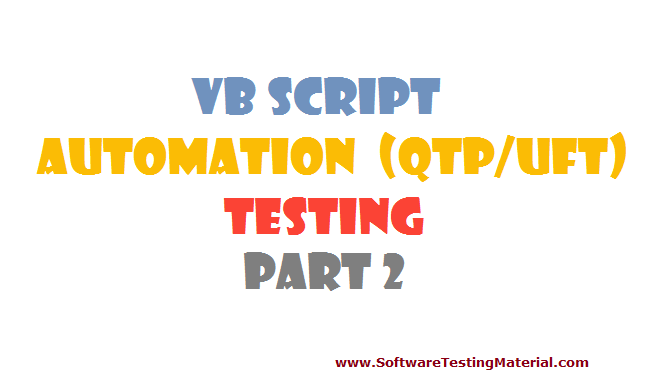
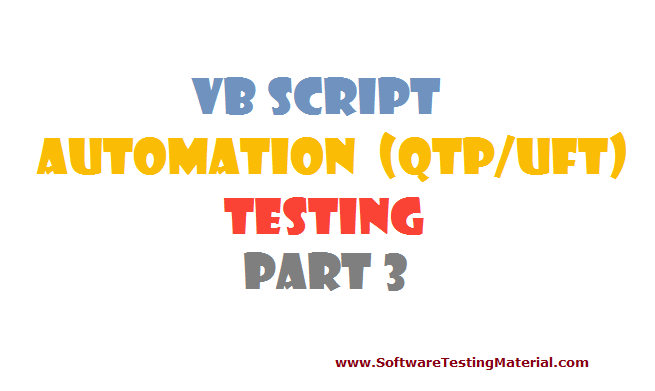
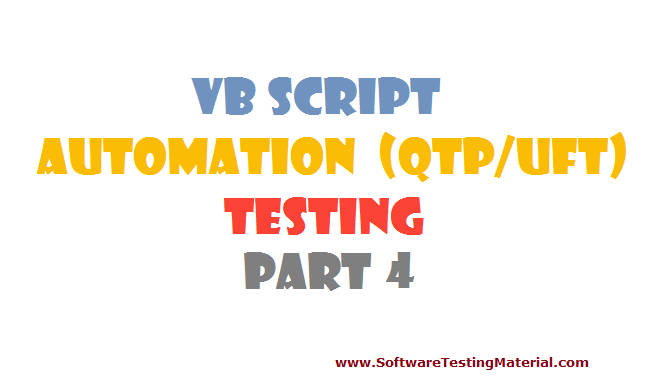
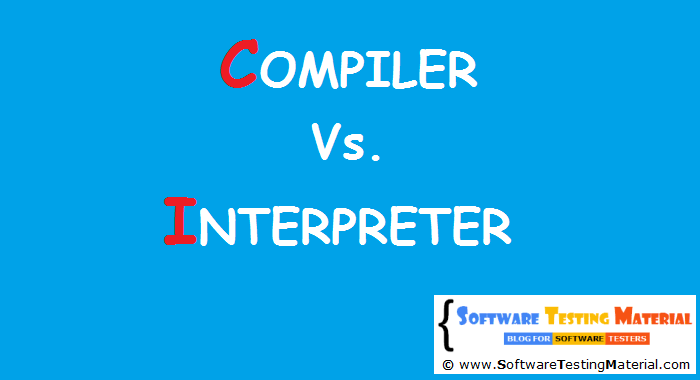
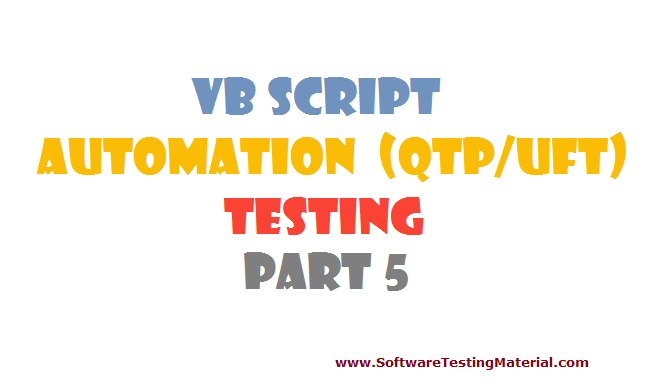
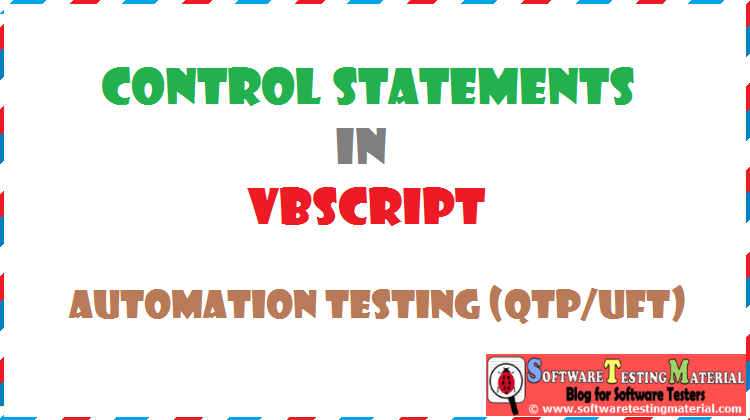
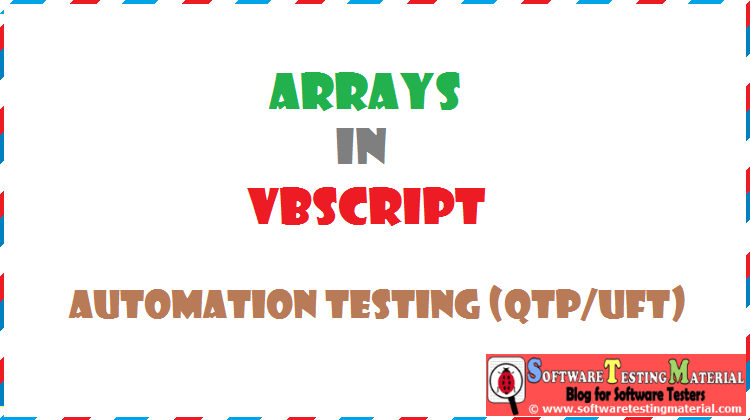
Valuble information. ….